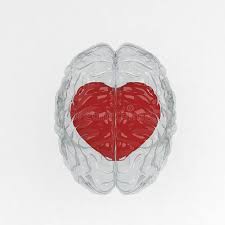Your brain loves you, even if sometimes, it has a funny way of showing it.

The brain named itself. The brain, doesn’t even understand how the brain works. One part of your brain can create a dream, whilst another part is surprised at that dream, or even fearful of it. Your brain has an average of 87 billion neurons, each one with around 10,000 connections to other neurons, and two neurons don’t even have to be directly next to one another to be connected. Despite how amazing and complex our brains are, people often feel “broken” or “crazy” when they experience mental health issues, even though their “symptoms”, are actually signs of survival.
In another blog post, I talk about triggers and implicit memories. I’ve lost count of how many clients have felt they’re going mad when they react to triggers and other post trauma symptoms, but what if our brain couldn’t do all of this for us?
Would we have survived as a species if we didn’t automatically remember, recognize and respond to a threat?
What if, as cave dwellers, we were bitten by a snake, then nonchalantly picked up each stick we found without a care in the world, before being bitten again? What if we had to make a conscious decision that something was a threat to us in the moment, and a conscious decision regarding how to deal with it? It’s tough enough trying to decide what to watch on Netflix, and our life doesn’t depend on that. What if our brain wasn’t hardwired for attachment to one another, and as cave men we simply wandered off into the jungle at the mercy of the very hungry predators, or left our helpless babies on a rock somewhere and ignored it’s cries?
We wouldn’t have survived long at all.
When we’re faced with a threat; be it a car heading towards us, a dangerous wild animal, or even a social threat such as humiliation, embarrassment or rejection, a part of our brain called the amygdala, which works a little like a smoke alarm, responds for us, automatically. Conscious choice doesn’t enter the equation. It responds quickly, too, in around 8/100th of a second. Our amygdala might cause us to fight, run away, freeze up like a rabbit in the headlights, make friends with whatever is threatening us, or go into damage limitation, also known as “fawn” or “flop”. It triggers another part of our brain to release chemicals which give us super strength or super speed, making our heart beat quicker and our muscles work harder. If we freeze, like a rabbit in the headlights, we stay very still, and we can’t speak. The parts of our brain which deal with speech and language shut down to help us stay as quiet as possible, so that a predator won’t hear us; this isn’t so helpful for an actor on stage who experiences “stage fright”.
When we face what our amygdala decides is certain death, our brain blows a fuse. We dissociate. Our brain floods itself with it’s natural pain relief to prevent us from feeling pain during our grizzly demise. The insula, a part of the brain which is a little like our body’s internal CCTV system shuts down. We may experience an outer body experience where we float above or to the side of ourselves, and observe, passively what’s happening to us, but feel a high with it. Our muscles go floppy, like rubber. Our sense of time is distorted. If we survive, we don’t remember the experience as such, sometimes not even bits of it and to protect us further, our brain can lock it away from us automatically. Right up until our final moments, our brain does it’s best to look after us. Sometimes, it keeps doing it for us long after the original threat has passed, just in case; better to treat a stick like a snake than a snake like a stick. It’s almost like, our smoke alarm should go off when we burn the toast in our kitchen to warn us of a fire, but sometimes, our brain’s smoke alarm can become so sensitive, it can sound the alarm before we’ve finished opening the bread bin. It can even remember for us what reaction helped us to survive the last threat, and use that reaction again and again.
It’s worth remembering that this isn’t just something we do, it’s common across the animal kingdom, and is a vital part of evolution.
Our brain can constantly warn us of threats around us; not just mistaking a stick for a snake, but sometimes convincing us that anything vaguely long, green and thin is a snake. Our brain finds ways of distracting us from the fragments of trauma memories which it itself brings into our conscious awareness, in an effort to keep us safe from experiencing the same trauma twice. If our brain has learnt that we are never safe, and that bad things always happen to us, it can try to help us to to be safe by causing us to avoid everything and everyone beyond the safety of our own doorstep. We can end up avoiding the feelings related to our threat, as well as reminders of the threat itself. To our amygdala, the consequences of this are far less important than our survival. This is a common part of conditions such as agoraphobia and social anxiety.
Where we have felt out of control, our brain might try to create the illusion of control for us; if we turn this light switch on and off 20 times before we leave, nothing bad will happen. If we don’t step on cracks in the pavement, we’ll make it home. Our brain tries it’s best to find any sort of balance, and regain what has been lost, whether it’s replacing a loss of control with control, or creating the illusion of calm where there has been anxiety.
Sometimes, our brain will be so desperate to make meaning of our traumatic experiences, it will have us create similar scenarios, so that we can do something different, or complete that uncompleted jigsaw puzzle. We may have a compulsion to repeat our trauma.
Our brain can recognize when it dysregulates us, so it can create mechanisms to help us regulate again. Cutting ourselves can release cortisol and adrenaline (the super strength and super speed brain chemicals) if we feel too numb, or can make our brain release it’s own brand ibuprofen if we need the inner pain to stop. Similarly, binging food releases dopamine (a “feel good chemical in our brain” and leaves us feeling “full” if we were previously empty, moving blood to our digestion system leaving us feeling tired. Purging, on the other hand releases adrenaline, which can not only relieve us of any numbness we have, but also counteract the obvious affects of the binging.
And if the inner turmoil won’t cease, when the conscious brain is exhausted from the unconscious and automatic brain’s raw survival mechanisms, it can even helps us to find an extreme and final solution to stop our pain; to end it all, even if it means ending our life.
Some of what our brain does may impact hugely on our daily life, but through it all, I believe it loves, protects and preserves us until the very last second; even if sometimes, it has a funny way of showing it.
This blog is intended for information and educational purposes only and is not intended to replace professional mental health support including diagnosis and treatment. This blog remains the property of the site author, and any un-authorized copy or publishing is prohibited.



